Entrepreneurship Report: Ventures, Skills and Economic Impact
VerifiedAdded on 2023/01/12
|19
|5051
|60
Report
AI Summary
This report comprehensively examines the multifaceted landscape of entrepreneurship, beginning with an introduction to the core concepts and the role of entrepreneurs in driving innovation. It then delves into different types of entrepreneurial ventures, including scalable, social, small business, and large company ventures, and their respective characteristics. The report analyzes the similarities and differences between these ventures, focusing on ownership structure, innovation, risk, and examples. Furthermore, it explores the impact of small and micro businesses on the economy, providing data and statistics on their contributions to economic growth, employment, and government revenue. The report also identifies the key characteristics, skills, and traits of successful entrepreneurs and discusses the influence of entrepreneurial personality on mindset and motivation. Finally, it considers the effect of background and experience on entrepreneurship, concluding with a synthesis of the key findings and their implications for aspiring entrepreneurs and the broader economy.

Entrepreneurship and
Small Business
Management
Small Business
Management
Paraphrase This Document
Need a fresh take? Get an instant paraphrase of this document with our AI Paraphraser
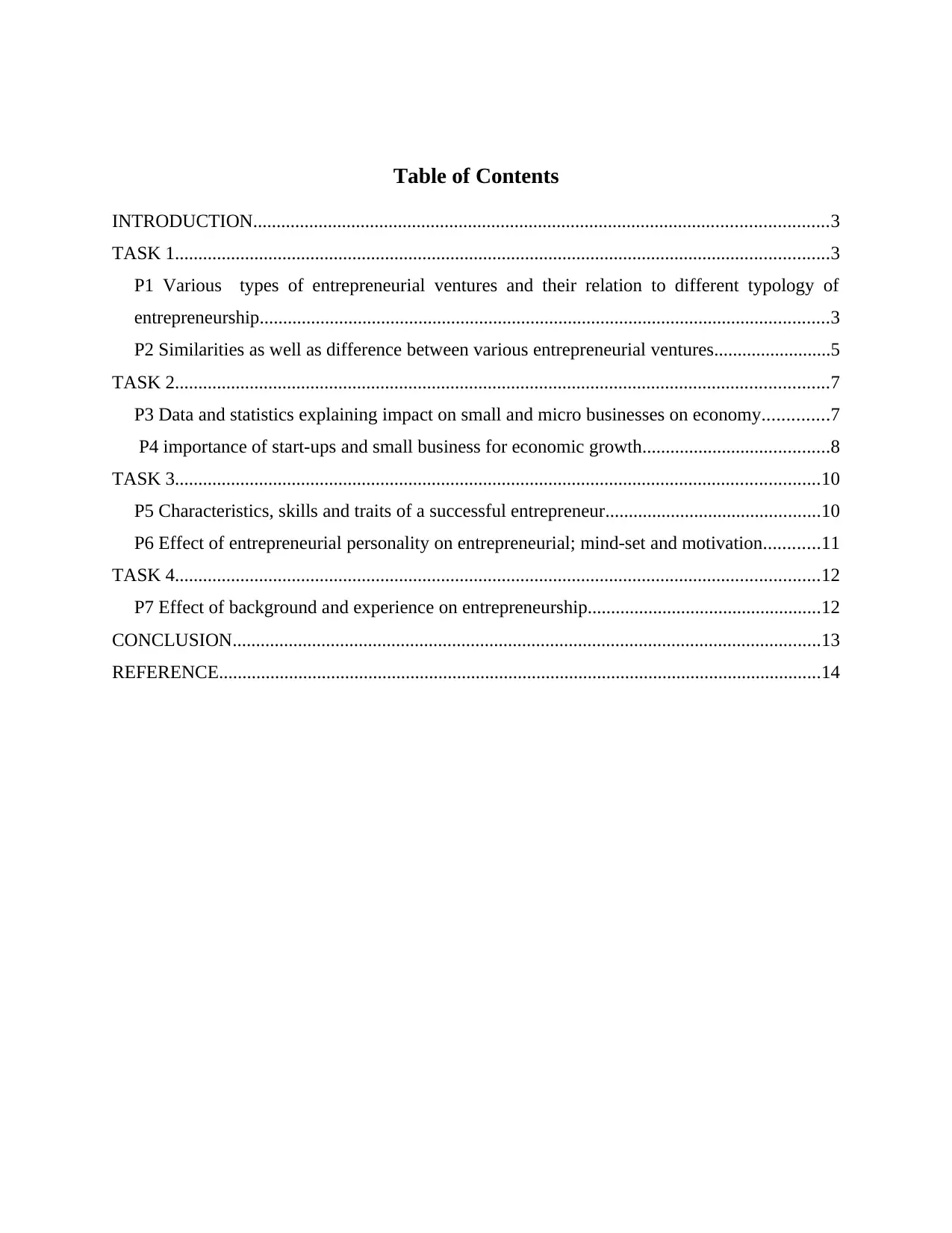
Table of Contents
INTRODUCTION...........................................................................................................................3
TASK 1............................................................................................................................................3
P1 Various types of entrepreneurial ventures and their relation to different typology of
entrepreneurship..........................................................................................................................3
P2 Similarities as well as difference between various entrepreneurial ventures.........................5
TASK 2............................................................................................................................................7
P3 Data and statistics explaining impact on small and micro businesses on economy..............7
P4 importance of start-ups and small business for economic growth........................................8
TASK 3..........................................................................................................................................10
P5 Characteristics, skills and traits of a successful entrepreneur..............................................10
P6 Effect of entrepreneurial personality on entrepreneurial; mind-set and motivation............11
TASK 4..........................................................................................................................................12
P7 Effect of background and experience on entrepreneurship..................................................12
CONCLUSION..............................................................................................................................13
REFERENCE.................................................................................................................................14
INTRODUCTION...........................................................................................................................3
TASK 1............................................................................................................................................3
P1 Various types of entrepreneurial ventures and their relation to different typology of
entrepreneurship..........................................................................................................................3
P2 Similarities as well as difference between various entrepreneurial ventures.........................5
TASK 2............................................................................................................................................7
P3 Data and statistics explaining impact on small and micro businesses on economy..............7
P4 importance of start-ups and small business for economic growth........................................8
TASK 3..........................................................................................................................................10
P5 Characteristics, skills and traits of a successful entrepreneur..............................................10
P6 Effect of entrepreneurial personality on entrepreneurial; mind-set and motivation............11
TASK 4..........................................................................................................................................12
P7 Effect of background and experience on entrepreneurship..................................................12
CONCLUSION..............................................................................................................................13
REFERENCE.................................................................................................................................14
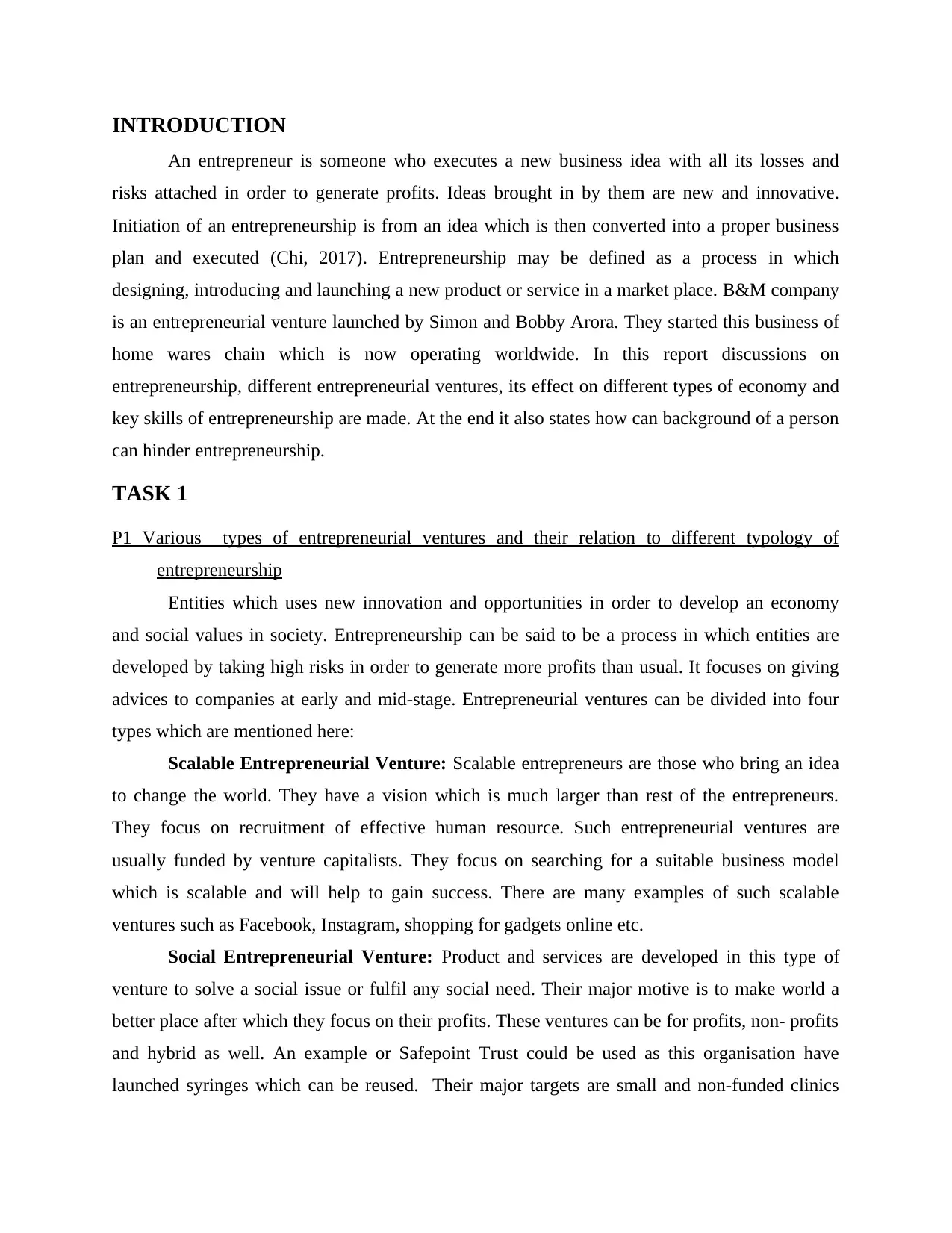
INTRODUCTION
An entrepreneur is someone who executes a new business idea with all its losses and
risks attached in order to generate profits. Ideas brought in by them are new and innovative.
Initiation of an entrepreneurship is from an idea which is then converted into a proper business
plan and executed (Chi, 2017). Entrepreneurship may be defined as a process in which
designing, introducing and launching a new product or service in a market place. B&M company
is an entrepreneurial venture launched by Simon and Bobby Arora. They started this business of
home wares chain which is now operating worldwide. In this report discussions on
entrepreneurship, different entrepreneurial ventures, its effect on different types of economy and
key skills of entrepreneurship are made. At the end it also states how can background of a person
can hinder entrepreneurship.
TASK 1
P1 Various types of entrepreneurial ventures and their relation to different typology of
entrepreneurship
Entities which uses new innovation and opportunities in order to develop an economy
and social values in society. Entrepreneurship can be said to be a process in which entities are
developed by taking high risks in order to generate more profits than usual. It focuses on giving
advices to companies at early and mid-stage. Entrepreneurial ventures can be divided into four
types which are mentioned here:
Scalable Entrepreneurial Venture: Scalable entrepreneurs are those who bring an idea
to change the world. They have a vision which is much larger than rest of the entrepreneurs.
They focus on recruitment of effective human resource. Such entrepreneurial ventures are
usually funded by venture capitalists. They focus on searching for a suitable business model
which is scalable and will help to gain success. There are many examples of such scalable
ventures such as Facebook, Instagram, shopping for gadgets online etc.
Social Entrepreneurial Venture: Product and services are developed in this type of
venture to solve a social issue or fulfil any social need. Their major motive is to make world a
better place after which they focus on their profits. These ventures can be for profits, non- profits
and hybrid as well. An example or Safepoint Trust could be used as this organisation have
launched syringes which can be reused. Their major targets are small and non-funded clinics
An entrepreneur is someone who executes a new business idea with all its losses and
risks attached in order to generate profits. Ideas brought in by them are new and innovative.
Initiation of an entrepreneurship is from an idea which is then converted into a proper business
plan and executed (Chi, 2017). Entrepreneurship may be defined as a process in which
designing, introducing and launching a new product or service in a market place. B&M company
is an entrepreneurial venture launched by Simon and Bobby Arora. They started this business of
home wares chain which is now operating worldwide. In this report discussions on
entrepreneurship, different entrepreneurial ventures, its effect on different types of economy and
key skills of entrepreneurship are made. At the end it also states how can background of a person
can hinder entrepreneurship.
TASK 1
P1 Various types of entrepreneurial ventures and their relation to different typology of
entrepreneurship
Entities which uses new innovation and opportunities in order to develop an economy
and social values in society. Entrepreneurship can be said to be a process in which entities are
developed by taking high risks in order to generate more profits than usual. It focuses on giving
advices to companies at early and mid-stage. Entrepreneurial ventures can be divided into four
types which are mentioned here:
Scalable Entrepreneurial Venture: Scalable entrepreneurs are those who bring an idea
to change the world. They have a vision which is much larger than rest of the entrepreneurs.
They focus on recruitment of effective human resource. Such entrepreneurial ventures are
usually funded by venture capitalists. They focus on searching for a suitable business model
which is scalable and will help to gain success. There are many examples of such scalable
ventures such as Facebook, Instagram, shopping for gadgets online etc.
Social Entrepreneurial Venture: Product and services are developed in this type of
venture to solve a social issue or fulfil any social need. Their major motive is to make world a
better place after which they focus on their profits. These ventures can be for profits, non- profits
and hybrid as well. An example or Safepoint Trust could be used as this organisation have
launched syringes which can be reused. Their major targets are small and non-funded clinics
⊘ This is a preview!⊘
Do you want full access?
Subscribe today to unlock all pages.

Trusted by 1+ million students worldwide
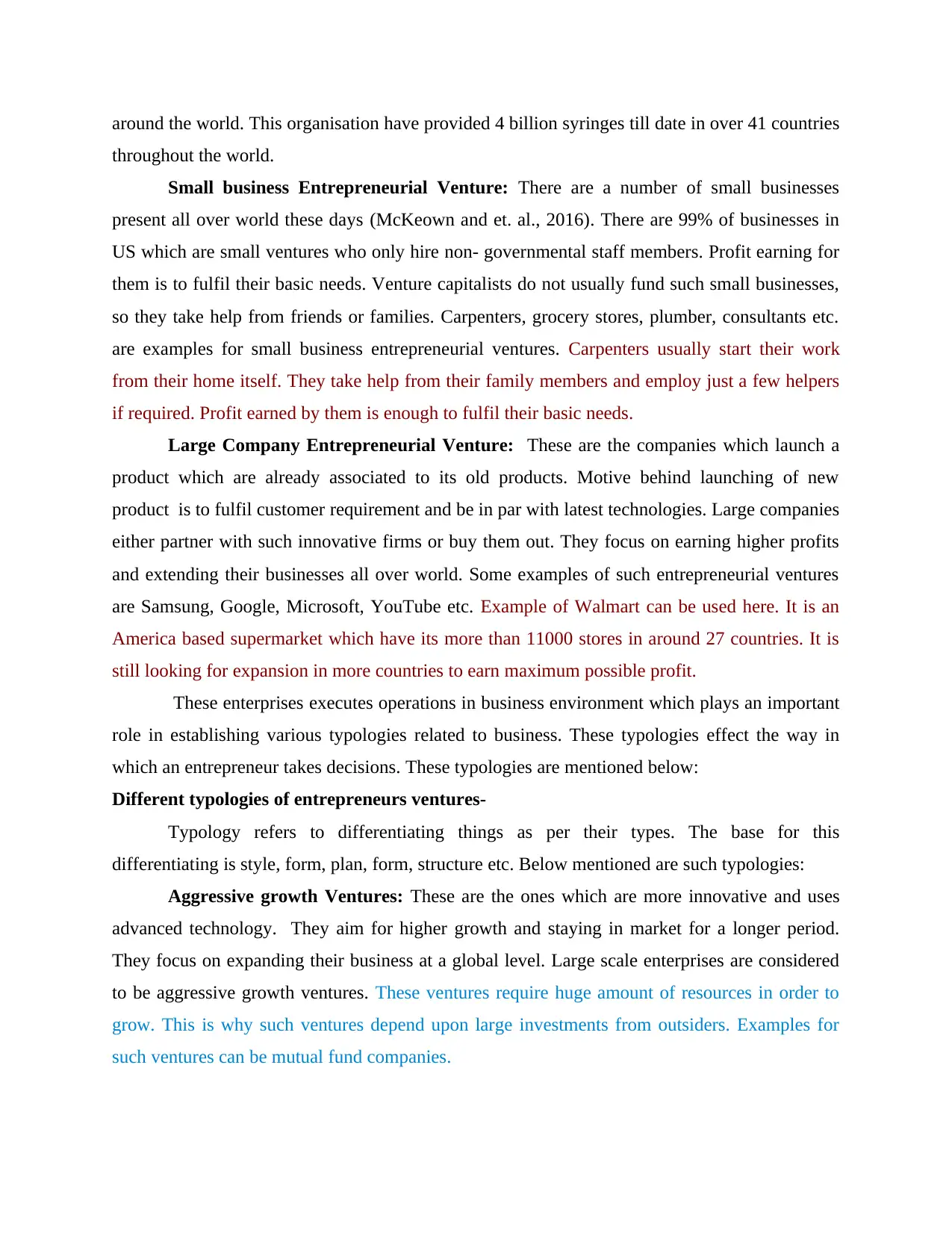
around the world. This organisation have provided 4 billion syringes till date in over 41 countries
throughout the world.
Small business Entrepreneurial Venture: There are a number of small businesses
present all over world these days (McKeown and et. al., 2016). There are 99% of businesses in
US which are small ventures who only hire non- governmental staff members. Profit earning for
them is to fulfil their basic needs. Venture capitalists do not usually fund such small businesses,
so they take help from friends or families. Carpenters, grocery stores, plumber, consultants etc.
are examples for small business entrepreneurial ventures. Carpenters usually start their work
from their home itself. They take help from their family members and employ just a few helpers
if required. Profit earned by them is enough to fulfil their basic needs.
Large Company Entrepreneurial Venture: These are the companies which launch a
product which are already associated to its old products. Motive behind launching of new
product is to fulfil customer requirement and be in par with latest technologies. Large companies
either partner with such innovative firms or buy them out. They focus on earning higher profits
and extending their businesses all over world. Some examples of such entrepreneurial ventures
are Samsung, Google, Microsoft, YouTube etc. Example of Walmart can be used here. It is an
America based supermarket which have its more than 11000 stores in around 27 countries. It is
still looking for expansion in more countries to earn maximum possible profit.
These enterprises executes operations in business environment which plays an important
role in establishing various typologies related to business. These typologies effect the way in
which an entrepreneur takes decisions. These typologies are mentioned below:
Different typologies of entrepreneurs ventures-
Typology refers to differentiating things as per their types. The base for this
differentiating is style, form, plan, form, structure etc. Below mentioned are such typologies:
Aggressive growth Ventures: These are the ones which are more innovative and uses
advanced technology. They aim for higher growth and staying in market for a longer period.
They focus on expanding their business at a global level. Large scale enterprises are considered
to be aggressive growth ventures. These ventures require huge amount of resources in order to
grow. This is why such ventures depend upon large investments from outsiders. Examples for
such ventures can be mutual fund companies.
throughout the world.
Small business Entrepreneurial Venture: There are a number of small businesses
present all over world these days (McKeown and et. al., 2016). There are 99% of businesses in
US which are small ventures who only hire non- governmental staff members. Profit earning for
them is to fulfil their basic needs. Venture capitalists do not usually fund such small businesses,
so they take help from friends or families. Carpenters, grocery stores, plumber, consultants etc.
are examples for small business entrepreneurial ventures. Carpenters usually start their work
from their home itself. They take help from their family members and employ just a few helpers
if required. Profit earned by them is enough to fulfil their basic needs.
Large Company Entrepreneurial Venture: These are the companies which launch a
product which are already associated to its old products. Motive behind launching of new
product is to fulfil customer requirement and be in par with latest technologies. Large companies
either partner with such innovative firms or buy them out. They focus on earning higher profits
and extending their businesses all over world. Some examples of such entrepreneurial ventures
are Samsung, Google, Microsoft, YouTube etc. Example of Walmart can be used here. It is an
America based supermarket which have its more than 11000 stores in around 27 countries. It is
still looking for expansion in more countries to earn maximum possible profit.
These enterprises executes operations in business environment which plays an important
role in establishing various typologies related to business. These typologies effect the way in
which an entrepreneur takes decisions. These typologies are mentioned below:
Different typologies of entrepreneurs ventures-
Typology refers to differentiating things as per their types. The base for this
differentiating is style, form, plan, form, structure etc. Below mentioned are such typologies:
Aggressive growth Ventures: These are the ones which are more innovative and uses
advanced technology. They aim for higher growth and staying in market for a longer period.
They focus on expanding their business at a global level. Large scale enterprises are considered
to be aggressive growth ventures. These ventures require huge amount of resources in order to
grow. This is why such ventures depend upon large investments from outsiders. Examples for
such ventures can be mutual fund companies.
Paraphrase This Document
Need a fresh take? Get an instant paraphrase of this document with our AI Paraphraser

Lifestyle Ventures: These ventures do not focus on growth or expansion rather they aim
at fulfilling satisfaction which an individual receives from income (Sharma, Singh and Singh,
2017). Lifestyle ventures have a limited number of staff and they work at a single place (Allen
and Truman, 2016). A small business organisation operating at only one place could be a
lifestyle venture. Such ventures depend heavily on skill, energy, personalit yand contacts of its
founders.Examples of lifestyle ventures can be bloggers, online stores, consultant advisors etc.
Managed growth Ventures: In this venture major motive of organisations is to expand
their operations and working worldwide in order to generate more profits (Yang and Meyer,
2019). They are good in management as they look for skilled staff an provide them with quality
raw materials which help them to reach to success. An example of managed growth ventures can
be scalable businesses. Examples of these ventures in today's scenario are various social media
platforms such as Facebook, Instagram etc.
Survival Ventures: Survival ventures are those which help with basic needs of living.
The are launched in order to increase standard of living in society. They also help in enhancing
social status of people. An example of such ventures can be micro businesses. They are also
called hand to mouth ventures. They give just enough profits to pay bills of entrepreneurs.
Examples of such businesses are selling hand made crafts etc.
P2 Similarities as well as difference between various entrepreneurial ventures
Similarities Social enterprise Scalable
entrepreneurial
ventures
Large company
entrepreneurial
ventures
1. Ownership structure It is owned by a group
of individual.
Governmental or non-
governmental.
They are owned by a
sole proprietor or a
group of individuals.
They also have
shareholders group
who own the
company.
2. Innovative business They come up wit
ideas to do a good
social cause.
They innovate a
scalable idea which
has never been
thought of earlier and
These enterprises
come up with ideas to
expand their
businesses around the
at fulfilling satisfaction which an individual receives from income (Sharma, Singh and Singh,
2017). Lifestyle ventures have a limited number of staff and they work at a single place (Allen
and Truman, 2016). A small business organisation operating at only one place could be a
lifestyle venture. Such ventures depend heavily on skill, energy, personalit yand contacts of its
founders.Examples of lifestyle ventures can be bloggers, online stores, consultant advisors etc.
Managed growth Ventures: In this venture major motive of organisations is to expand
their operations and working worldwide in order to generate more profits (Yang and Meyer,
2019). They are good in management as they look for skilled staff an provide them with quality
raw materials which help them to reach to success. An example of managed growth ventures can
be scalable businesses. Examples of these ventures in today's scenario are various social media
platforms such as Facebook, Instagram etc.
Survival Ventures: Survival ventures are those which help with basic needs of living.
The are launched in order to increase standard of living in society. They also help in enhancing
social status of people. An example of such ventures can be micro businesses. They are also
called hand to mouth ventures. They give just enough profits to pay bills of entrepreneurs.
Examples of such businesses are selling hand made crafts etc.
P2 Similarities as well as difference between various entrepreneurial ventures
Similarities Social enterprise Scalable
entrepreneurial
ventures
Large company
entrepreneurial
ventures
1. Ownership structure It is owned by a group
of individual.
Governmental or non-
governmental.
They are owned by a
sole proprietor or a
group of individuals.
They also have
shareholders group
who own the
company.
2. Innovative business They come up wit
ideas to do a good
social cause.
They innovate a
scalable idea which
has never been
thought of earlier and
These enterprises
come up with ideas to
expand their
businesses around the
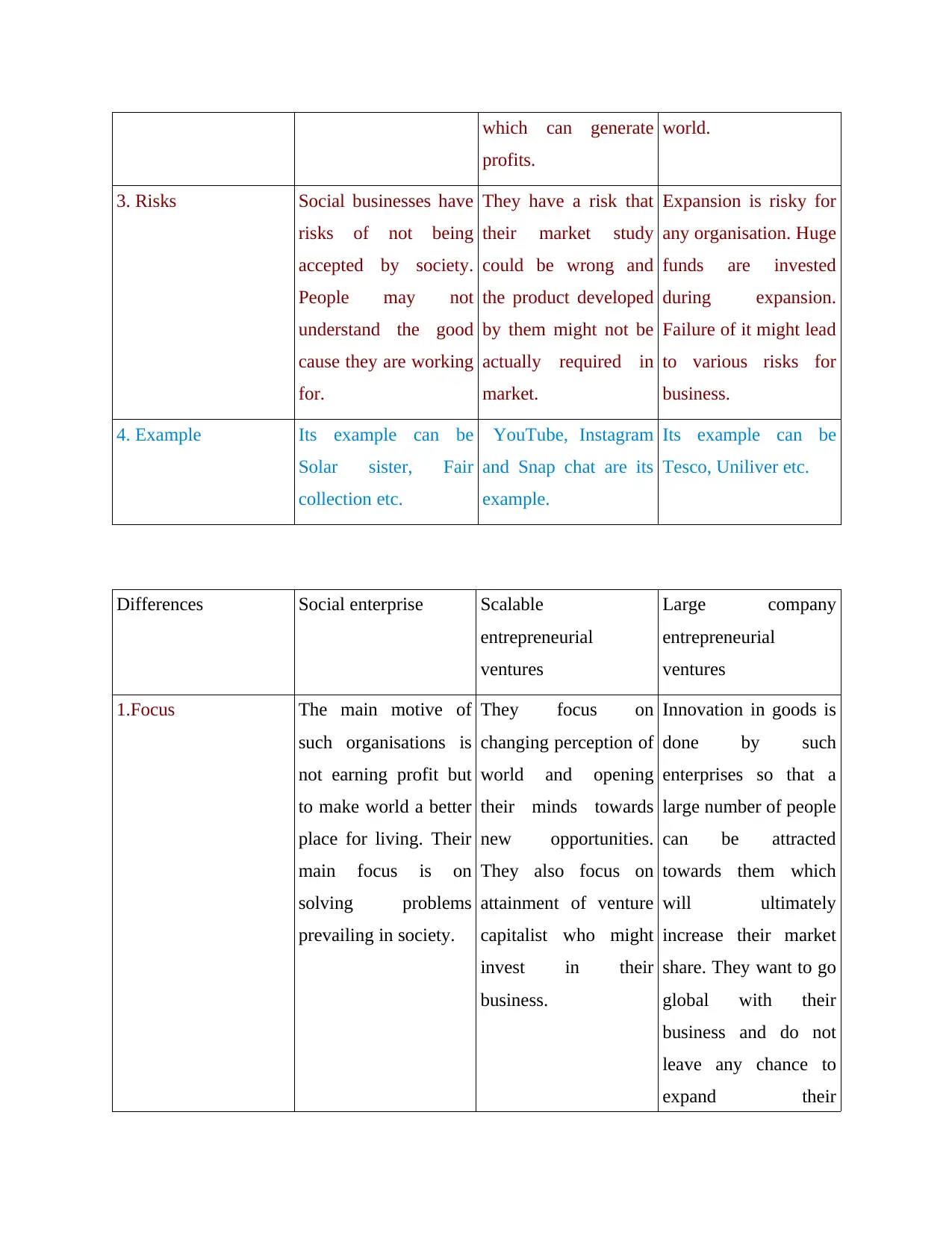
which can generate
profits.
world.
3. Risks Social businesses have
risks of not being
accepted by society.
People may not
understand the good
cause they are working
for.
They have a risk that
their market study
could be wrong and
the product developed
by them might not be
actually required in
market.
Expansion is risky for
any organisation. Huge
funds are invested
during expansion.
Failure of it might lead
to various risks for
business.
4. Example Its example can be
Solar sister, Fair
collection etc.
YouTube, Instagram
and Snap chat are its
example.
Its example can be
Tesco, Uniliver etc.
Differences Social enterprise Scalable
entrepreneurial
ventures
Large company
entrepreneurial
ventures
1.Focus The main motive of
such organisations is
not earning profit but
to make world a better
place for living. Their
main focus is on
solving problems
prevailing in society.
They focus on
changing perception of
world and opening
their minds towards
new opportunities.
They also focus on
attainment of venture
capitalist who might
invest in their
business.
Innovation in goods is
done by such
enterprises so that a
large number of people
can be attracted
towards them which
will ultimately
increase their market
share. They want to go
global with their
business and do not
leave any chance to
expand their
profits.
world.
3. Risks Social businesses have
risks of not being
accepted by society.
People may not
understand the good
cause they are working
for.
They have a risk that
their market study
could be wrong and
the product developed
by them might not be
actually required in
market.
Expansion is risky for
any organisation. Huge
funds are invested
during expansion.
Failure of it might lead
to various risks for
business.
4. Example Its example can be
Solar sister, Fair
collection etc.
YouTube, Instagram
and Snap chat are its
example.
Its example can be
Tesco, Uniliver etc.
Differences Social enterprise Scalable
entrepreneurial
ventures
Large company
entrepreneurial
ventures
1.Focus The main motive of
such organisations is
not earning profit but
to make world a better
place for living. Their
main focus is on
solving problems
prevailing in society.
They focus on
changing perception of
world and opening
their minds towards
new opportunities.
They also focus on
attainment of venture
capitalist who might
invest in their
business.
Innovation in goods is
done by such
enterprises so that a
large number of people
can be attracted
towards them which
will ultimately
increase their market
share. They want to go
global with their
business and do not
leave any chance to
expand their
⊘ This is a preview!⊘
Do you want full access?
Subscribe today to unlock all pages.

Trusted by 1+ million students worldwide
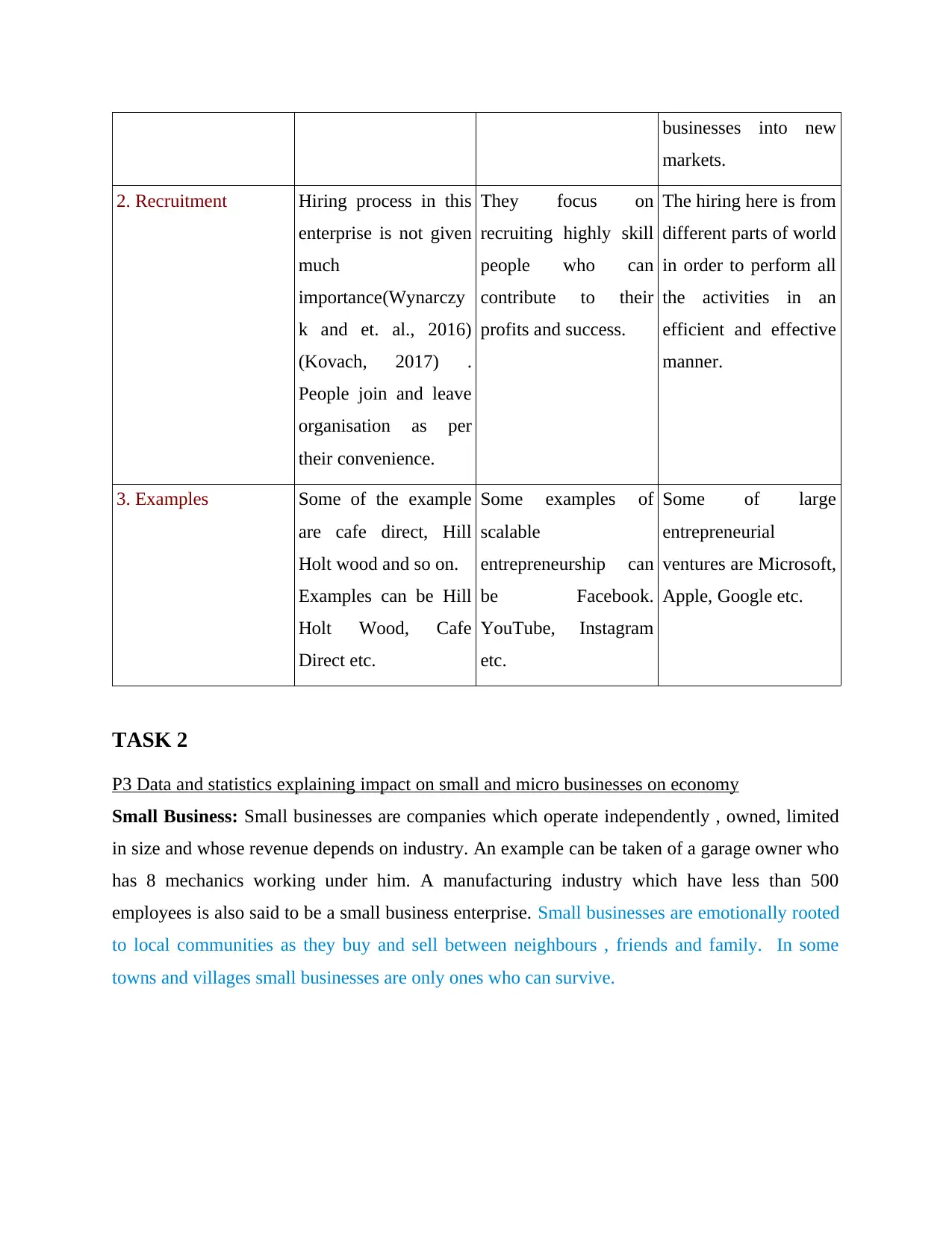
businesses into new
markets.
2. Recruitment Hiring process in this
enterprise is not given
much
importance(Wynarczy
k and et. al., 2016)
(Kovach, 2017) .
People join and leave
organisation as per
their convenience.
They focus on
recruiting highly skill
people who can
contribute to their
profits and success.
The hiring here is from
different parts of world
in order to perform all
the activities in an
efficient and effective
manner.
3. Examples Some of the example
are cafe direct, Hill
Holt wood and so on.
Examples can be Hill
Holt Wood, Cafe
Direct etc.
Some examples of
scalable
entrepreneurship can
be Facebook.
YouTube, Instagram
etc.
Some of large
entrepreneurial
ventures are Microsoft,
Apple, Google etc.
TASK 2
P3 Data and statistics explaining impact on small and micro businesses on economy
Small Business: Small businesses are companies which operate independently , owned, limited
in size and whose revenue depends on industry. An example can be taken of a garage owner who
has 8 mechanics working under him. A manufacturing industry which have less than 500
employees is also said to be a small business enterprise. Small businesses are emotionally rooted
to local communities as they buy and sell between neighbours , friends and family. In some
towns and villages small businesses are only ones who can survive.
markets.
2. Recruitment Hiring process in this
enterprise is not given
much
importance(Wynarczy
k and et. al., 2016)
(Kovach, 2017) .
People join and leave
organisation as per
their convenience.
They focus on
recruiting highly skill
people who can
contribute to their
profits and success.
The hiring here is from
different parts of world
in order to perform all
the activities in an
efficient and effective
manner.
3. Examples Some of the example
are cafe direct, Hill
Holt wood and so on.
Examples can be Hill
Holt Wood, Cafe
Direct etc.
Some examples of
scalable
entrepreneurship can
be Facebook.
YouTube, Instagram
etc.
Some of large
entrepreneurial
ventures are Microsoft,
Apple, Google etc.
TASK 2
P3 Data and statistics explaining impact on small and micro businesses on economy
Small Business: Small businesses are companies which operate independently , owned, limited
in size and whose revenue depends on industry. An example can be taken of a garage owner who
has 8 mechanics working under him. A manufacturing industry which have less than 500
employees is also said to be a small business enterprise. Small businesses are emotionally rooted
to local communities as they buy and sell between neighbours , friends and family. In some
towns and villages small businesses are only ones who can survive.
Paraphrase This Document
Need a fresh take? Get an instant paraphrase of this document with our AI Paraphraser
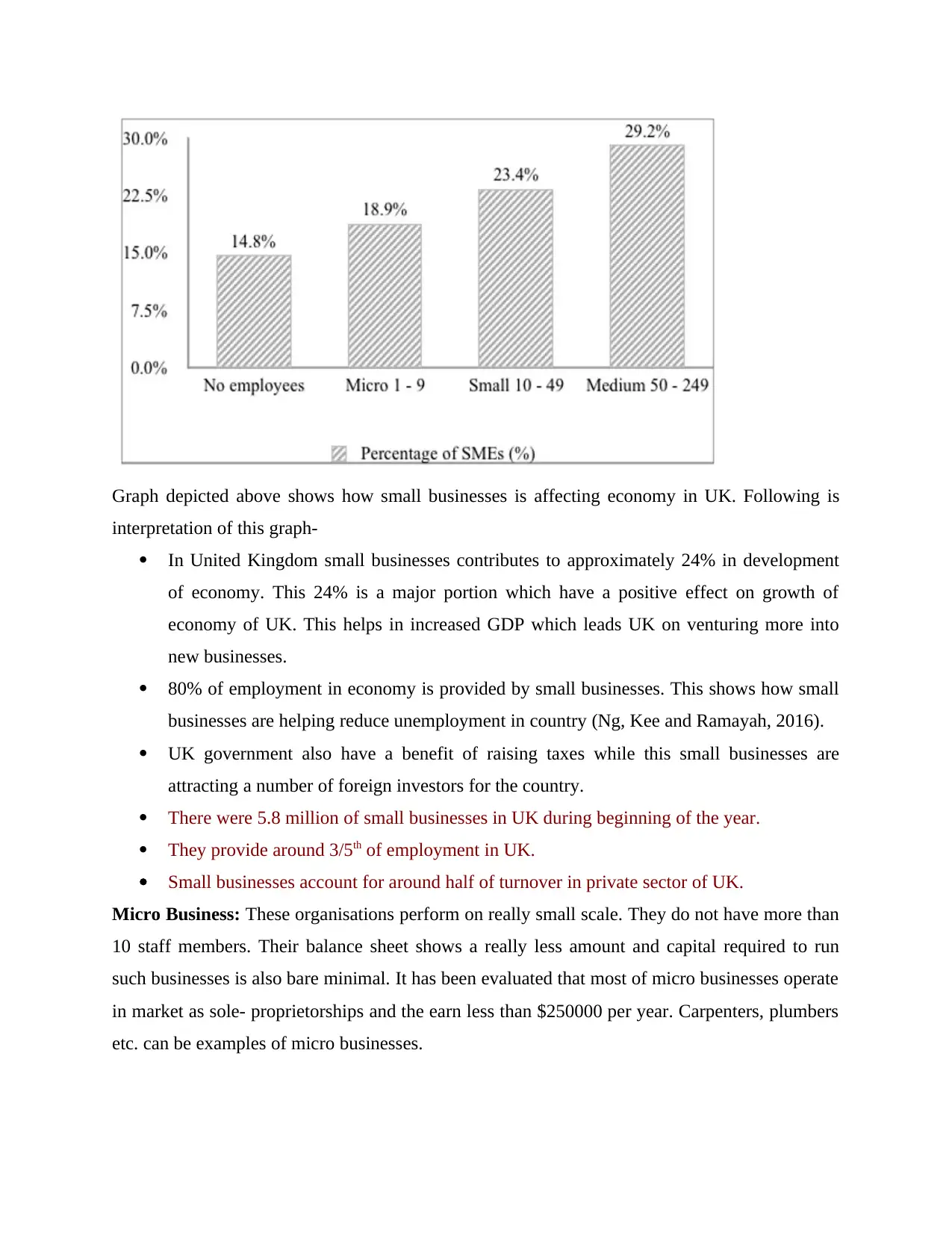
Graph depicted above shows how small businesses is affecting economy in UK. Following is
interpretation of this graph-
In United Kingdom small businesses contributes to approximately 24% in development
of economy. This 24% is a major portion which have a positive effect on growth of
economy of UK. This helps in increased GDP which leads UK on venturing more into
new businesses.
80% of employment in economy is provided by small businesses. This shows how small
businesses are helping reduce unemployment in country (Ng, Kee and Ramayah, 2016).
UK government also have a benefit of raising taxes while this small businesses are
attracting a number of foreign investors for the country.
There were 5.8 million of small businesses in UK during beginning of the year.
They provide around 3/5th of employment in UK.
Small businesses account for around half of turnover in private sector of UK.
Micro Business: These organisations perform on really small scale. They do not have more than
10 staff members. Their balance sheet shows a really less amount and capital required to run
such businesses is also bare minimal. It has been evaluated that most of micro businesses operate
in market as sole- proprietorships and the earn less than $250000 per year. Carpenters, plumbers
etc. can be examples of micro businesses.
interpretation of this graph-
In United Kingdom small businesses contributes to approximately 24% in development
of economy. This 24% is a major portion which have a positive effect on growth of
economy of UK. This helps in increased GDP which leads UK on venturing more into
new businesses.
80% of employment in economy is provided by small businesses. This shows how small
businesses are helping reduce unemployment in country (Ng, Kee and Ramayah, 2016).
UK government also have a benefit of raising taxes while this small businesses are
attracting a number of foreign investors for the country.
There were 5.8 million of small businesses in UK during beginning of the year.
They provide around 3/5th of employment in UK.
Small businesses account for around half of turnover in private sector of UK.
Micro Business: These organisations perform on really small scale. They do not have more than
10 staff members. Their balance sheet shows a really less amount and capital required to run
such businesses is also bare minimal. It has been evaluated that most of micro businesses operate
in market as sole- proprietorships and the earn less than $250000 per year. Carpenters, plumbers
etc. can be examples of micro businesses.
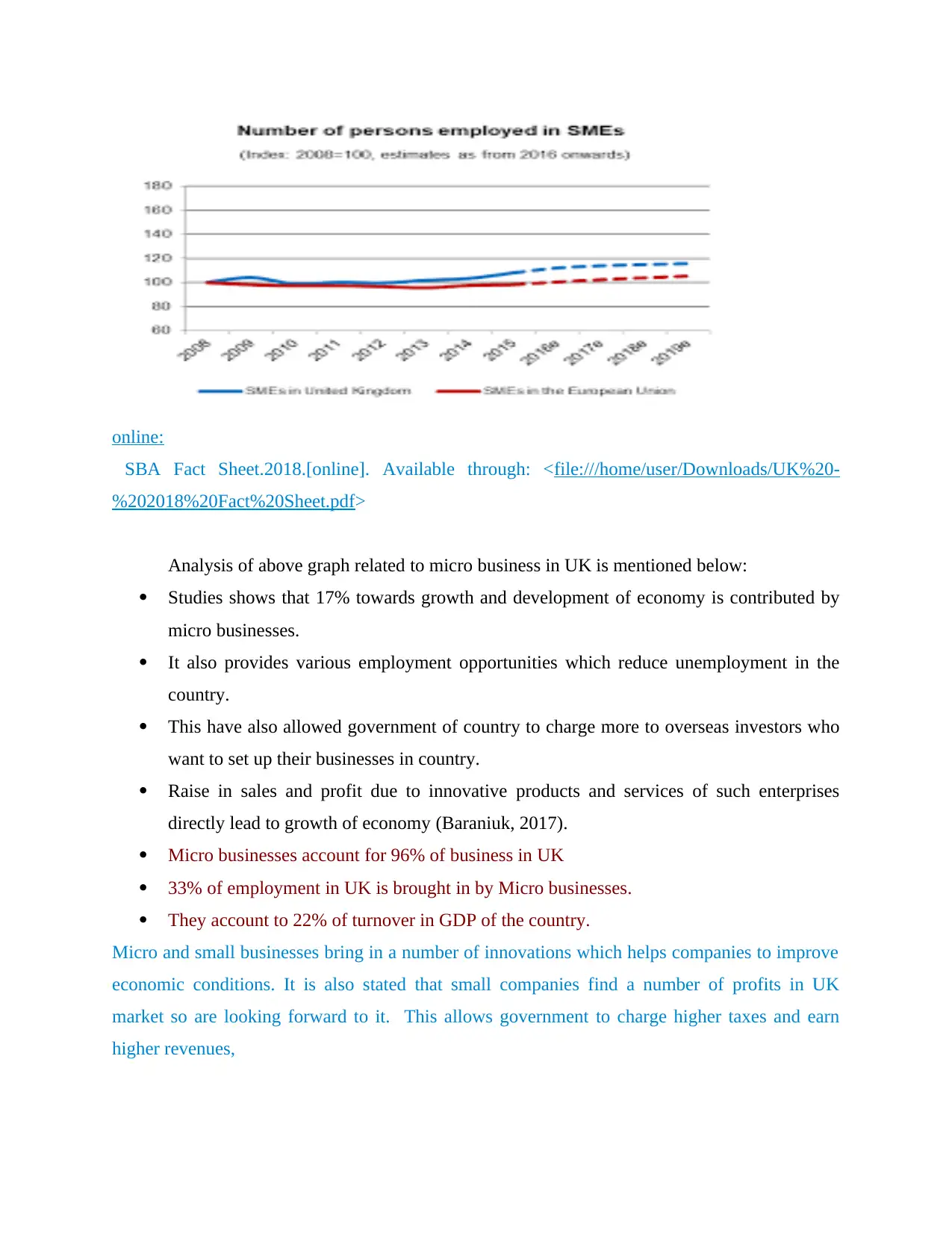
online:
SBA Fact Sheet.2018.[online]. Available through: <file:///home/user/Downloads/UK%20-
%202018%20Fact%20Sheet.pdf>
Analysis of above graph related to micro business in UK is mentioned below:
Studies shows that 17% towards growth and development of economy is contributed by
micro businesses.
It also provides various employment opportunities which reduce unemployment in the
country.
This have also allowed government of country to charge more to overseas investors who
want to set up their businesses in country.
Raise in sales and profit due to innovative products and services of such enterprises
directly lead to growth of economy (Baraniuk, 2017).
Micro businesses account for 96% of business in UK
33% of employment in UK is brought in by Micro businesses.
They account to 22% of turnover in GDP of the country.
Micro and small businesses bring in a number of innovations which helps companies to improve
economic conditions. It is also stated that small companies find a number of profits in UK
market so are looking forward to it. This allows government to charge higher taxes and earn
higher revenues,
SBA Fact Sheet.2018.[online]. Available through: <file:///home/user/Downloads/UK%20-
%202018%20Fact%20Sheet.pdf>
Analysis of above graph related to micro business in UK is mentioned below:
Studies shows that 17% towards growth and development of economy is contributed by
micro businesses.
It also provides various employment opportunities which reduce unemployment in the
country.
This have also allowed government of country to charge more to overseas investors who
want to set up their businesses in country.
Raise in sales and profit due to innovative products and services of such enterprises
directly lead to growth of economy (Baraniuk, 2017).
Micro businesses account for 96% of business in UK
33% of employment in UK is brought in by Micro businesses.
They account to 22% of turnover in GDP of the country.
Micro and small businesses bring in a number of innovations which helps companies to improve
economic conditions. It is also stated that small companies find a number of profits in UK
market so are looking forward to it. This allows government to charge higher taxes and earn
higher revenues,
⊘ This is a preview!⊘
Do you want full access?
Subscribe today to unlock all pages.

Trusted by 1+ million students worldwide
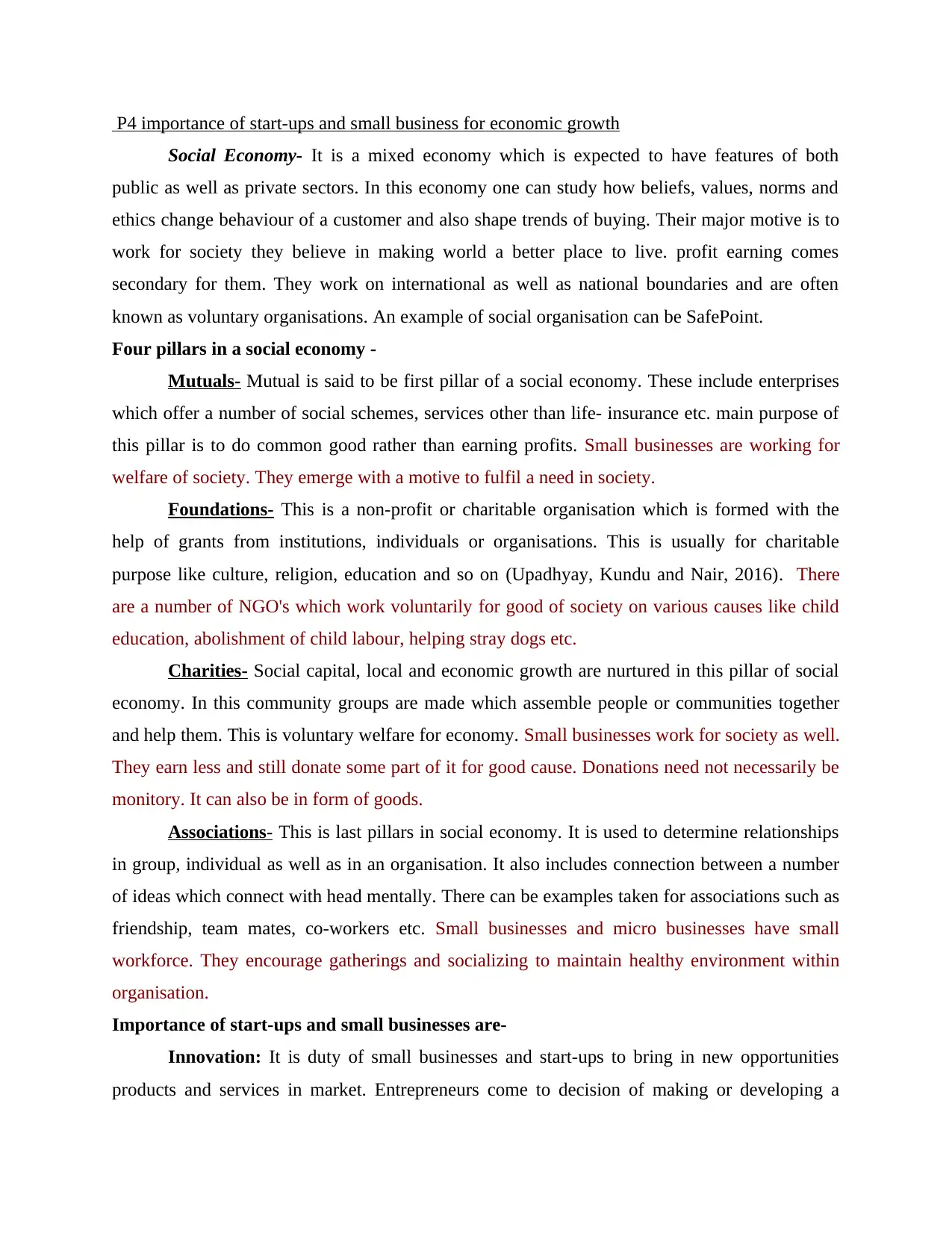
P4 importance of start-ups and small business for economic growth
Social Economy- It is a mixed economy which is expected to have features of both
public as well as private sectors. In this economy one can study how beliefs, values, norms and
ethics change behaviour of a customer and also shape trends of buying. Their major motive is to
work for society they believe in making world a better place to live. profit earning comes
secondary for them. They work on international as well as national boundaries and are often
known as voluntary organisations. An example of social organisation can be SafePoint.
Four pillars in a social economy -
Mutuals- Mutual is said to be first pillar of a social economy. These include enterprises
which offer a number of social schemes, services other than life- insurance etc. main purpose of
this pillar is to do common good rather than earning profits. Small businesses are working for
welfare of society. They emerge with a motive to fulfil a need in society.
Foundations- This is a non-profit or charitable organisation which is formed with the
help of grants from institutions, individuals or organisations. This is usually for charitable
purpose like culture, religion, education and so on (Upadhyay, Kundu and Nair, 2016). There
are a number of NGO's which work voluntarily for good of society on various causes like child
education, abolishment of child labour, helping stray dogs etc.
Charities- Social capital, local and economic growth are nurtured in this pillar of social
economy. In this community groups are made which assemble people or communities together
and help them. This is voluntary welfare for economy. Small businesses work for society as well.
They earn less and still donate some part of it for good cause. Donations need not necessarily be
monitory. It can also be in form of goods.
Associations- This is last pillars in social economy. It is used to determine relationships
in group, individual as well as in an organisation. It also includes connection between a number
of ideas which connect with head mentally. There can be examples taken for associations such as
friendship, team mates, co-workers etc. Small businesses and micro businesses have small
workforce. They encourage gatherings and socializing to maintain healthy environment within
organisation.
Importance of start-ups and small businesses are-
Innovation: It is duty of small businesses and start-ups to bring in new opportunities
products and services in market. Entrepreneurs come to decision of making or developing a
Social Economy- It is a mixed economy which is expected to have features of both
public as well as private sectors. In this economy one can study how beliefs, values, norms and
ethics change behaviour of a customer and also shape trends of buying. Their major motive is to
work for society they believe in making world a better place to live. profit earning comes
secondary for them. They work on international as well as national boundaries and are often
known as voluntary organisations. An example of social organisation can be SafePoint.
Four pillars in a social economy -
Mutuals- Mutual is said to be first pillar of a social economy. These include enterprises
which offer a number of social schemes, services other than life- insurance etc. main purpose of
this pillar is to do common good rather than earning profits. Small businesses are working for
welfare of society. They emerge with a motive to fulfil a need in society.
Foundations- This is a non-profit or charitable organisation which is formed with the
help of grants from institutions, individuals or organisations. This is usually for charitable
purpose like culture, religion, education and so on (Upadhyay, Kundu and Nair, 2016). There
are a number of NGO's which work voluntarily for good of society on various causes like child
education, abolishment of child labour, helping stray dogs etc.
Charities- Social capital, local and economic growth are nurtured in this pillar of social
economy. In this community groups are made which assemble people or communities together
and help them. This is voluntary welfare for economy. Small businesses work for society as well.
They earn less and still donate some part of it for good cause. Donations need not necessarily be
monitory. It can also be in form of goods.
Associations- This is last pillars in social economy. It is used to determine relationships
in group, individual as well as in an organisation. It also includes connection between a number
of ideas which connect with head mentally. There can be examples taken for associations such as
friendship, team mates, co-workers etc. Small businesses and micro businesses have small
workforce. They encourage gatherings and socializing to maintain healthy environment within
organisation.
Importance of start-ups and small businesses are-
Innovation: It is duty of small businesses and start-ups to bring in new opportunities
products and services in market. Entrepreneurs come to decision of making or developing a
Paraphrase This Document
Need a fresh take? Get an instant paraphrase of this document with our AI Paraphraser
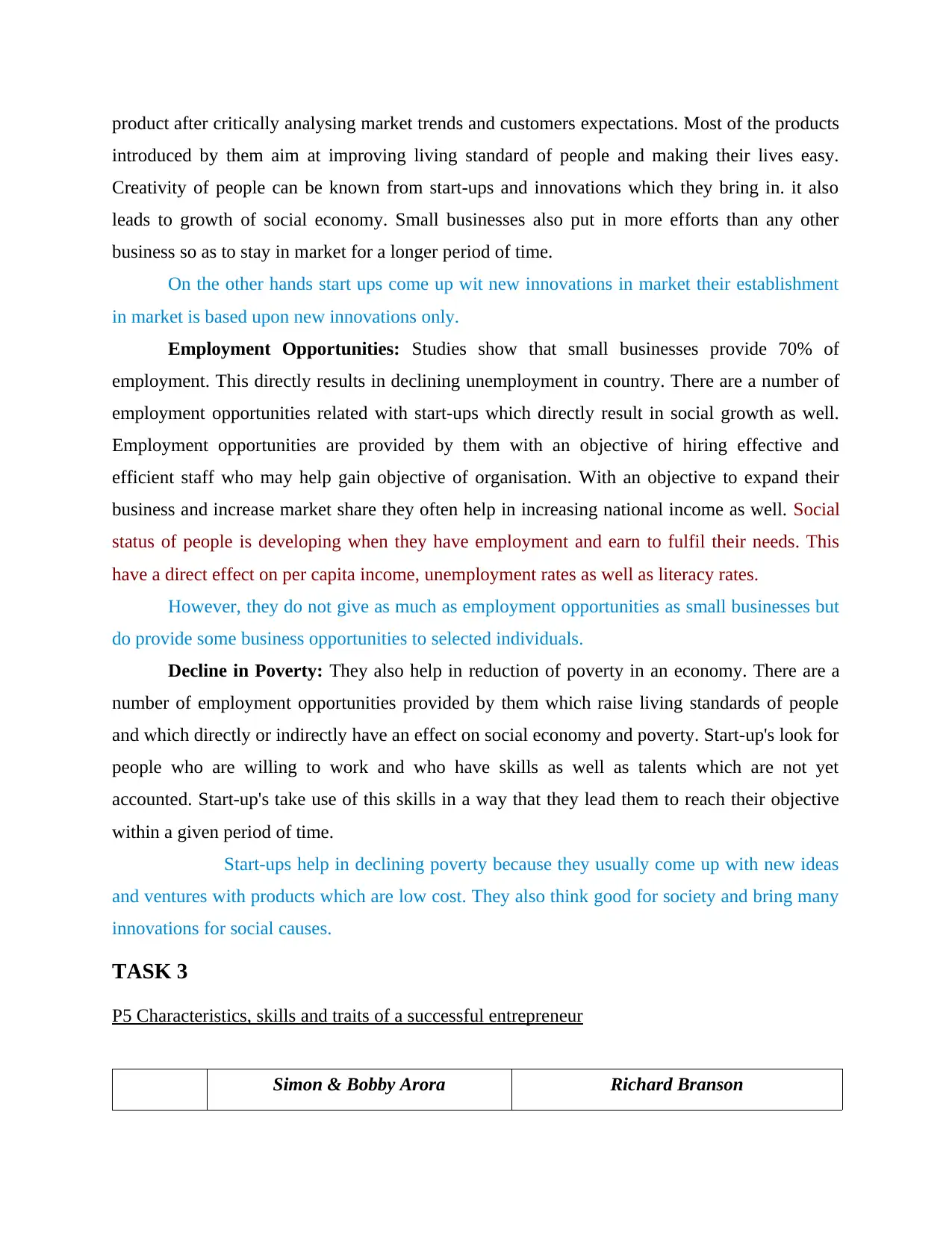
product after critically analysing market trends and customers expectations. Most of the products
introduced by them aim at improving living standard of people and making their lives easy.
Creativity of people can be known from start-ups and innovations which they bring in. it also
leads to growth of social economy. Small businesses also put in more efforts than any other
business so as to stay in market for a longer period of time.
On the other hands start ups come up wit new innovations in market their establishment
in market is based upon new innovations only.
Employment Opportunities: Studies show that small businesses provide 70% of
employment. This directly results in declining unemployment in country. There are a number of
employment opportunities related with start-ups which directly result in social growth as well.
Employment opportunities are provided by them with an objective of hiring effective and
efficient staff who may help gain objective of organisation. With an objective to expand their
business and increase market share they often help in increasing national income as well. Social
status of people is developing when they have employment and earn to fulfil their needs. This
have a direct effect on per capita income, unemployment rates as well as literacy rates.
However, they do not give as much as employment opportunities as small businesses but
do provide some business opportunities to selected individuals.
Decline in Poverty: They also help in reduction of poverty in an economy. There are a
number of employment opportunities provided by them which raise living standards of people
and which directly or indirectly have an effect on social economy and poverty. Start-up's look for
people who are willing to work and who have skills as well as talents which are not yet
accounted. Start-up's take use of this skills in a way that they lead them to reach their objective
within a given period of time.
Start-ups help in declining poverty because they usually come up with new ideas
and ventures with products which are low cost. They also think good for society and bring many
innovations for social causes.
TASK 3
P5 Characteristics, skills and traits of a successful entrepreneur
Simon & Bobby Arora Richard Branson
introduced by them aim at improving living standard of people and making their lives easy.
Creativity of people can be known from start-ups and innovations which they bring in. it also
leads to growth of social economy. Small businesses also put in more efforts than any other
business so as to stay in market for a longer period of time.
On the other hands start ups come up wit new innovations in market their establishment
in market is based upon new innovations only.
Employment Opportunities: Studies show that small businesses provide 70% of
employment. This directly results in declining unemployment in country. There are a number of
employment opportunities related with start-ups which directly result in social growth as well.
Employment opportunities are provided by them with an objective of hiring effective and
efficient staff who may help gain objective of organisation. With an objective to expand their
business and increase market share they often help in increasing national income as well. Social
status of people is developing when they have employment and earn to fulfil their needs. This
have a direct effect on per capita income, unemployment rates as well as literacy rates.
However, they do not give as much as employment opportunities as small businesses but
do provide some business opportunities to selected individuals.
Decline in Poverty: They also help in reduction of poverty in an economy. There are a
number of employment opportunities provided by them which raise living standards of people
and which directly or indirectly have an effect on social economy and poverty. Start-up's look for
people who are willing to work and who have skills as well as talents which are not yet
accounted. Start-up's take use of this skills in a way that they lead them to reach their objective
within a given period of time.
Start-ups help in declining poverty because they usually come up with new ideas
and ventures with products which are low cost. They also think good for society and bring many
innovations for social causes.
TASK 3
P5 Characteristics, skills and traits of a successful entrepreneur
Simon & Bobby Arora Richard Branson
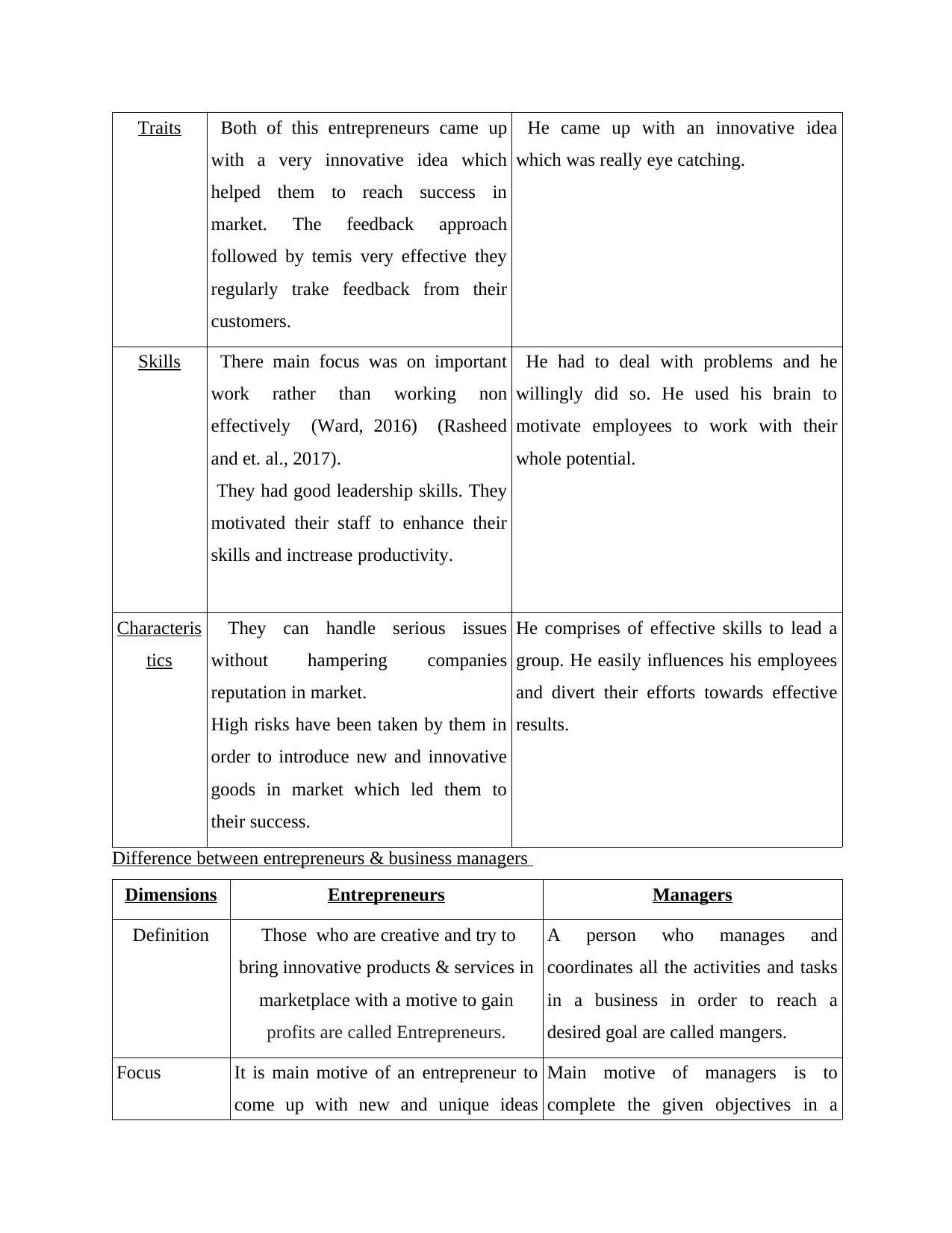
Traits Both of this entrepreneurs came up
with a very innovative idea which
helped them to reach success in
market. The feedback approach
followed by temis very effective they
regularly trake feedback from their
customers.
He came up with an innovative idea
which was really eye catching.
Skills There main focus was on important
work rather than working non
effectively (Ward, 2016) (Rasheed
and et. al., 2017).
They had good leadership skills. They
motivated their staff to enhance their
skills and inctrease productivity.
He had to deal with problems and he
willingly did so. He used his brain to
motivate employees to work with their
whole potential.
Characteris
tics
They can handle serious issues
without hampering companies
reputation in market.
High risks have been taken by them in
order to introduce new and innovative
goods in market which led them to
their success.
He comprises of effective skills to lead a
group. He easily influences his employees
and divert their efforts towards effective
results.
Difference between entrepreneurs & business managers
Dimensions Entrepreneurs Managers
Definition Those who are creative and try to
bring innovative products & services in
marketplace with a motive to gain
profits are called Entrepreneurs.
A person who manages and
coordinates all the activities and tasks
in a business in order to reach a
desired goal are called mangers.
Focus It is main motive of an entrepreneur to
come up with new and unique ideas
Main motive of managers is to
complete the given objectives in a
with a very innovative idea which
helped them to reach success in
market. The feedback approach
followed by temis very effective they
regularly trake feedback from their
customers.
He came up with an innovative idea
which was really eye catching.
Skills There main focus was on important
work rather than working non
effectively (Ward, 2016) (Rasheed
and et. al., 2017).
They had good leadership skills. They
motivated their staff to enhance their
skills and inctrease productivity.
He had to deal with problems and he
willingly did so. He used his brain to
motivate employees to work with their
whole potential.
Characteris
tics
They can handle serious issues
without hampering companies
reputation in market.
High risks have been taken by them in
order to introduce new and innovative
goods in market which led them to
their success.
He comprises of effective skills to lead a
group. He easily influences his employees
and divert their efforts towards effective
results.
Difference between entrepreneurs & business managers
Dimensions Entrepreneurs Managers
Definition Those who are creative and try to
bring innovative products & services in
marketplace with a motive to gain
profits are called Entrepreneurs.
A person who manages and
coordinates all the activities and tasks
in a business in order to reach a
desired goal are called mangers.
Focus It is main motive of an entrepreneur to
come up with new and unique ideas
Main motive of managers is to
complete the given objectives in a
⊘ This is a preview!⊘
Do you want full access?
Subscribe today to unlock all pages.

Trusted by 1+ million students worldwide
1 out of 19
Related Documents
Your All-in-One AI-Powered Toolkit for Academic Success.
+13062052269
info@desklib.com
Available 24*7 on WhatsApp / Email
![[object Object]](/_next/static/media/star-bottom.7253800d.svg)
Unlock your academic potential
Copyright © 2020–2025 A2Z Services. All Rights Reserved. Developed and managed by ZUCOL.





